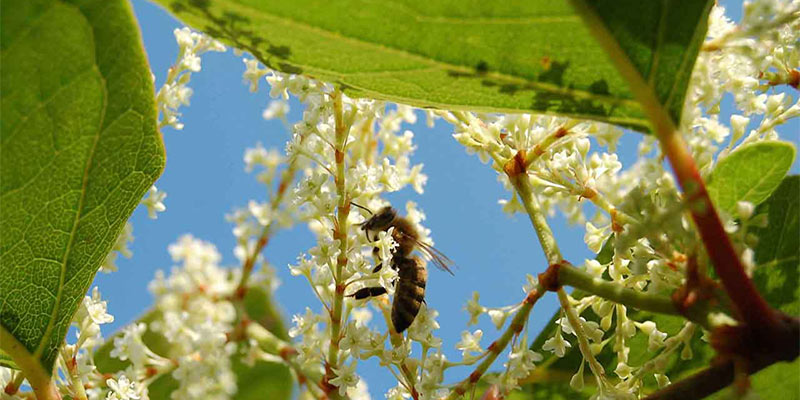
Japanese knotweed is a highly invasive ornamental garden plant introduced to Britain by the Victorians in the 1800s. It’s almost impossible to control and eradicate and can cause serious damage to buildings, car parks and asphalt driveways by exploiting cracks and weaknesses.
If you have Japanese knotweed in your garden, you’ll probably know about it, and so will your neighbour. Dakota Murphey, working alongside law firm George Ide, has given you exactly what the dangers are and how you can deal with the problem?
What is Japanese knotweed?
Japanese knotweed (Fallopia japonica) is a plant that grows up to 3 metres tall and has light green leaves shaped like a shield. Resembling bamboo, the stem is light green in colour, and has a reddish-pink speckle. The flowers are long, thin clusters of creamy-white sprays, and the roots, called rhizomes, are an orangey-yellow inside. The plant dies back in winter, leaving tall brown canes but growth is renewed each year from the rhizomes, which spread relentlessly. Numerous plants look similar to Knotweed, so learning how to identify Japanese knotweed as early as possible is essential.
Knotweed problems
In their search for moisture, knotweed rhizomes can cause blockages to drain pipes and sometimes lift pipes and clog up sumps. Underground cables and sewerage pipes can also be affected. When growing close to walls and buildings, knotweed can push up through concrete and brick, causing major damage.
Knotweed and the law
Although knotweed can pose serious problems and should be removed, there are no regulations forcing you to do so. However, in terms of the Wildlife & Countryside Act 1981 (as amended), you would be breaking the law if you allowed the plant to spread from your property into the wild. The accepted distance it can spread underground is 7 metres, or 23 feet.
If you’re thinking of selling your home, and Japanese knotweed is present, it can greatly affect the valuation. In their assessments of properties, surveyors will take into account the risk of damage from knotweed. Where it’s considered a danger to the property, it must be eradicated by implementing a Japanese knotweed management plan.
Removing the plant
Once knotweed has been cut down or dug up, the plant material then has to be taken to a licensed landfill site with the facilities to deal with it. If you dispose of it anywhere else, you will have contravened the Environmental Protection Act 1990.
Once removed, you should apply a herbicide, twice in the first year and then once a year until the plant has completely disappeared. The property should be checked for any regrowth for the next two years, at which time it can be officially declared free of Japanese knotweed.
How to keep Japanese knotweed out of your property
To keep knotweed out of your garden, make sure that any soil brought onto the property is guaranteed to be Japanese knotweed free, and that any machinery, tools and other equipment that come onto the property are clean and free from knotweed rhizomes.
Community Protection Notices
The police and local councils have the power to issue Community Protection Notices against ‘individuals who act unreasonably, or who persistently or continually act in a way that has a detrimental effect on the quality of life of those in the locality’. Invasive, non-native species like Japanese knotweed are included in these notices, so if an individual or organisation does not control or eradicate Japanese knotweed, and could be reasonably expected to do so, a notice could be issued.
A Community Protection Notice forces the individual or organisation to remove Japanese knotweed within a specific period of time and prevent further growth in the future. Breaching a Community Protection Notice is a criminal offence, and attracts a fine of £100 for an individual, or up to £20,000 for an organisation.
Some final tips
- As soon as you see signs of Japanese knotweed growing on your property, make plans to get rid of it. The longer you leave it, the more growth will occur and the bigger and more difficult the job will become.
- If you’re selling your property and have knotweed, don’t just cut the plant down and cover it up with soil. The problem will come back to haunt you when the plant regrows, and there could be a legal claim against you.
- If you do cut down and dig up the plant’s rhizomes, do not throw the material onto the local authority compost, as you’ll be breaking the law. In any event, Japanese knotweed will not necessarily be killed by the composting process and the rhizomes will almost certainly contaminate the compost.
- If necessary, you can get advice from the Environment Agency, Natural Resources Wales, the Scottish Environment Protection Agency (SEPA), the Northern Ireland Environment Agency or an experienced property solicitor.
